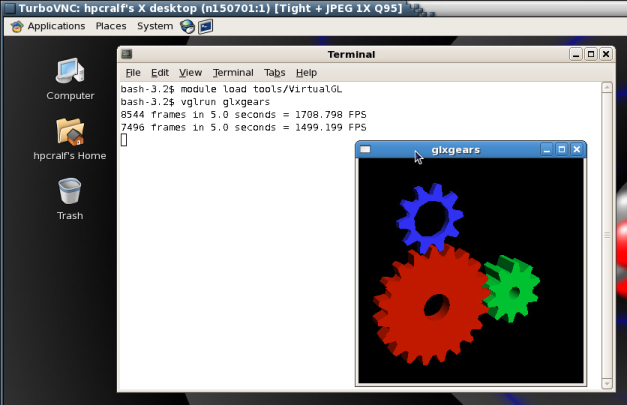- Infos im HLRS Wiki sind nicht rechtsverbindlich und ohne Gewähr -
- Information contained in the HLRS Wiki is not legally binding and HLRS is not responsible for any damages that might result from its use -
Graphic Environment
For graphical pre- and post-processing purposes there is 1 visualisation nodes installed in the Nehalem cluster. The node is equipped with a nVIDIA Quadro 5800 FX and has 8 GB memory. Access to the nodes is possible via ssh.
user@cl3fr1>ssh n150701
To use the graphic hardware for remote rendering there are currently two ways tested. The first is via TurboVNC the second one is directly via VirtualGL.
VNC Setup
If you want to use the Nehalem Graphic Hardware e.g. for graphical pre- and post-processing, on way to do it is via a vnc-connection.
Linux
For that purpose you have to install TurboVNC on your local machine. TurboVNC comes as a pre-compiled package which can be downloaded from http://www.virtualgl.org/Downloads/TurboVNC.
Preparation of Nehalem Cluster
Before using vnc for the first time you have to log on to the Nehalem frontend and run
vncpasswd
which creates you a .vnc directory in your home containing a passwd file.
Starting the TurboVNC server
To start a TurboVNC server you simply have to login to the visualisation node n150701 via ssh.
user@client>ssh cl3fr1.hww.de user@cl3fr1>ssh n150701
Then load the VirtualGL module to setup the TurboVNC environment and start the TurboVNC server.
user@n150701>module load tools/VirtualGL user@n150701>turbovncserver
The TurboVNC server returns a display number which you have to use when connecting to the server from your client.
user@client>/opt/TurboVNC/bin/vncviewer -via cl3fr1.hww.de n150701:<Display#>
Enter the vnc password you set on the frontend and you should get a Gnome session running in your TurboVNC viewer. To execute 64Bit GL Applications within this session you have to open a shell and again load the VirtualGL module to set the VirtualGL environment and then start the application with the VirtualGL wrapper command
vglrun <Application command>
VirtualGL Setup
To use VirtualGL you have to install it on your local client. It is available in the form of pre-compiled packages at http://www.virtualgl.org/Downloads/VirtualGL.
Linux
After the installation of VirtualGL you can connect to cl3fr1.hww.de via the vglconnect command
user@client>vglconnect -s cl3fr1.hww.de
Then connect to the visualisation node n150701 via the vglconnect command
user@cl3fr1>module load tools/VirtualGL user@cl3fr1>vglconnect -s n150701
On the visualisation node you can then execute 64Bit GL applications with the VirtualGL wrapper command
user@n150701>module load tools/VirtualGL user@cl3fr1>vglrun <Application command>
